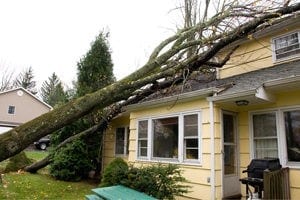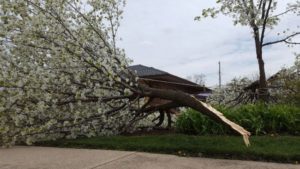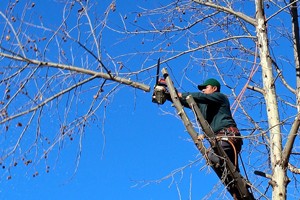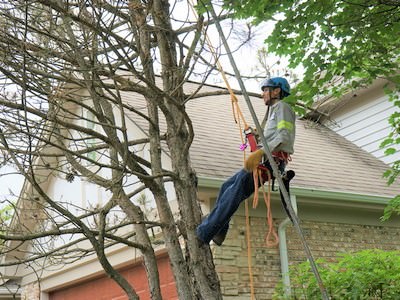Protect Your Trees From Weather Disasters

Winter and early spring can be a perilous time for trees. Snow and ice can wreak havoc on branches and roots, and extreme temperatures can also cause stress. While you can’t shelter your trees from all weather disasters, you can follow some easy storm season tree safety tips to protect them—and yourself.
Keep tree limbs pruned
Overgrown limbs can pose a risk to passersby or your property. During the winter months, trees are in their dormant stages of growth—and it’s an ideal time to prune. Locating and removing weak-jointed branches is important to protect both you and your tree. We pay extra attention during pruning to weak, narrow-angled, v-shaped branch crotches, as these are often most susceptible to breakage. Additionally, branches over your house, sidewalk, or car can be cabled or braced for added protection.
Resist the temptation to shake your branches
When winter storms come through, tree branches are often laden with snow. Sometimes, the branches even droop or bend under the snow’s weight. Resist the temptation to shake those branches. Cold and ice can make them brittle, and you could damage them beyond repair. Instead, let nature take its course.
Stay away from branches laden with ice and snow
This one may be common sense but is worth emphasizing—don’t park or walk under branches laden with snow or ice.
Be vigilant about salt use
Areas that receive a lot of snow typically use a lot of salt on roads and sidewalks. The salt can definitely damage your tree. Avoid shoveling a bank of snow around the base of your tree, as the salt in the snow can damage the roots, bark, and other aspects of the tree. If there is a bank of snow around your tree, consider using a gentle watering to wash away some of the snow and salt when the weather permits.
Protect your trees from snowplows
That bank of snow around a tree’s base can also mean it’s harder for snowplows to see where the tree is. As a result, snowplows could hit your tree, causing a wound that’s not evident until spring. Trees planted on parkways and roadsides are most vulnerable.
Take care of breakage right away
If a snow or ice storm comes through, and you notice broken or damaged limbs, call a tree service right away. Broken limbs disrupt a tree’s circulatory system and should be addressed as soon as the weather allows. It’s possible that prompt attention will help prevent further damage to your tree.
If you’ve done all this, and a winter (or early spring) storm comes through and severely damages or downs your tree, you’ll want to act quickly to call for emergency tree removal.
Keep these storm season tree safety tips in mind:
- Keep away from damaged trees. You don’t want to walk or park under obviously damaged branches. Keep cars, small children, and pets away from the damaged tree.
- Call for service right away. Contend with the situation quickly, as a damaged tree is a liability. Look for a 24/7 emergency tree removal service in your area—at Advanced Tree Care, we pride ourselves on quick response time and serve a two-state, nine-county area.
- Hire a licensed, bonded service led by a certified arborist, such as Advanced Tree Care. Tree work can be complex and mistakes are costly, so entrust the job to an expert like us.
Advanced Tree Care combines top-notch equipment, cutting-edge technology, and well-trained staff to provide emergency tree removal and tree maintenance services. With a presence in nine counties and two states, we work daily to provide unparalleled customer service, safety, and efficiency—as well as the expertise to beautify your landscaping and community. Advanced Tree Care isn’t just our name—it’s also our purpose!




